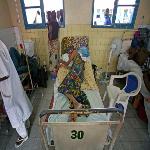Treating people infected with the AIDS virus involves using a combination of antiretroviral drugs. But some combinations work better than others. Now, a mathematical formula has been developed that may eventually help doctors decide which drugs to use.
Prescribing a cocktail of drugs has become the gold standard in preventing HIV from replicating. It's called HAART, which stands for highly active antiretroviral therapy. The cocktail combinations may be changed periodically to prevent the virus from building up resistance.
The new math
The new mathematical formula is based on a 5-year analysis of how the drugs keep HIV in check.

Johns Hopkins University
Dr. Robert Siliciano, Profess of medicine, Johns HopkinsDr. Robert Siliciano, senior study investigator and a specialist in infectious disease, said, "I've always been interested in why some combinations of HIV drugs work well and some don't. Most of the progress in the HIV treatment field in terms of deciding which treatments should be used in patients has been based on empirical studies – trial and error clinical trials – in which different combinations are tested against each other. And you look at how many patients after one year of treatment have (an) undetectable level of virus."
Siliciano is a professor of medicine at Johns Hopkins University.
"There hasn't been a lot of theoretical basis of why some combinations should work better than others. [With] what we know about how the virus replicates, it should be possible at least to predict some aspects of treatment outcome, specifically how well the drugs actually inhibit the virus," he said.
What works, what doesn't
The study analyzed how well individual drugs and drug combinations inhibit infection. Researchers then fed that data into computers and applied their mathematical formula.
"The standard way to do this is to look at the amount of drug that gives you 50 percent inhibition. That turns out to be a very poor way of doing it because at least some of the drugs are actually extremely good and they cause way, way more than 50 percent inhibition," he said.
In fact, some drugs are more than 99 percent effective in inhibiting HIV from replicating. Those are the antiretrovirals included in the study.
"Because the virus replicates exponentially," said Siliciano, "it can increase very, very quickly, and so that's why you need that extremely high level of inhibition."
Siliciano and his fellow researchers used 19 drugs and came up with well over 800 treatment combinations. He said while more study of the mathematical formula is needed, he foresees two uses. The first, of course, is treatment.
"Actually most of the people who have HIV infection are not on treatment right now. And treatments are not available in many areas. And the treatments are very costly and complicated. So if you really understand how well individual drugs and drug combinations work, it may be possible to figure out what is the simplest treatment that would be effective and that could be made more widely available," he said.
The formula could also help prevent drug resistance.
"Resistance is a very big problem when people either don't get an adequate supply of drugs or don't take the drugs correctly. Resistance can develop very easily. And the current ways of evaluating what to do for patients who have resistance need to be improved and this mathematical analysis I think gives us a way to do that," he said.
He said the next focus will be to come up with a drug regimen against which HIV is unable to develop any resistance.
